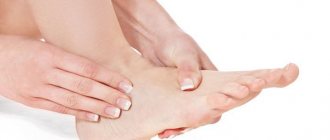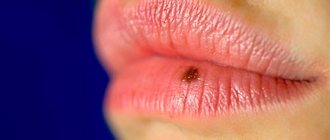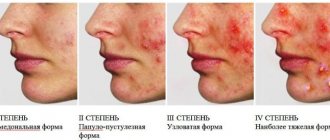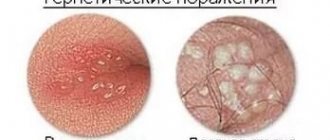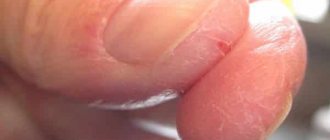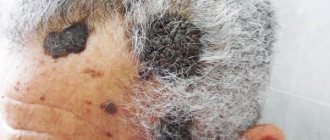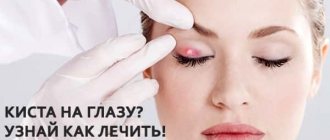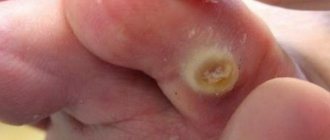A callus is a local injury to the upper layer of the epidermis resulting from prolonged mechanical impact. In appearance, these damages come in two types: dry and wet. Calluses are not considered a serious disease, but they cause significant inconvenience and pain to their owner when walking, and can also lead to the development of complications. Therefore, you need to start treating a wet callus immediately after it appears.
Causes of pathology, symptoms and consequences
Wet calli appear on the feet or hands.
They are caused by friction or pressure on an area of skin over a long period of time. When uncomfortable shoes rub, dropsy appears on the heels or toes. They can appear on your hands if you work without gloves, from playing musical instruments or when playing sports.
Some diseases also lead to their occurrence:
- arthritis;
- lack of vitamins;
- excess weight;
- sweaty feet;
- flat feet.
During excessive pressure or friction, the top layer of the dermis peels off. The space that has formed is filled with a clear liquid. Water callus protects against infection entering the blood.
Improper exposure of the epidermis causes redness and swelling. The rubbed area will begin to hurt. These are the first symptoms of a wet callus.
If the cause is eliminated at this moment, there will be no dropsy. The affected area should be covered with a plaster. If you don’t get rid of the cause, education will definitely arise.
Differences from other types of calluses
There are two main types of calluses: dry and wet . A dry or hard callus can be a regular callus or a core callus. Dry corns are also classified as dry. Wet callus has the following distinctive features:
- Occurs during or immediately after exposure to a damaging factor;
- May occur after the first contact with a hard surface (for example, wearing shoes for the first time);
- Represented as a bubble with transparent or red contents;
- Has signs of inflammation : redness, pain, local increase in temperature;
- The stratum corneum of the epidermis at the site of the callus becomes thinner and moves away from the underlying layers .
Dry callus occurs after prolonged constant contact with a damaging factor and never shows signs of inflammation. The stratum corneum of the epidermis thickens here, becomes white and grows more densely to the underlying layers.
Photo 2. Most often, wet calluses occur on the feet. Due to incorrectly selected shoes. Source: Flickr (danny v).
Benefits of treatment
It is necessary to treat the resulting growth with liquid in any case. Treatment with traditional methods will help get rid of the symptoms of the disease and prevent complications. The tools you will need are in every kitchen.
If callus occurs due to uncomfortable shoes, there is no need to immediately run to the doctor. Often, dropsy clears up in a few minutes.
A very important condition is sterility. So, if you pierce a formation, you cannot use the first object you come across. It is better to take the needle after disinfecting it first.
Folk remedies involve the use of baths, compresses, ointments and creams prepared at home.
In case of suppuration, you should immediately consult a doctor. Home treatment will make the situation worse.
Be proactive
Unlike large dropsy, small calluses do not cause pain and do not open on their own; they are simply covered with a bandage to prevent further injury. Discomfort and painful sensations are caused by large dropsy, which are ready to burst at any moment. Therefore, in this case, you should act proactively and pierce them.
The most favorable period for carrying out such manipulation is the day on which the wet callus was discovered.
Folk recipes
To safely get rid of the resulting pathology, use home remedies.
Ingredients that every housewife will need, for example, onions, tomatoes, potatoes and others. Different products are used for different purposes.
Lotions and compresses
You can prepare a compress for dropsy from aloe. The juice of this plant has a beneficial effect on the condition of the skin. Aloe softens and moisturizes the epidermis.
To prepare the composition you will need:
- aloe leaves - they must be fresh, no more than 4 hours after they are cut;
- salicylic acid;
- parchment;
- bandage or plaster.
The preparation method involves grinding aloe and applying it to the damaged area:
1 Grind the leaves using a blender. It should be a paste.
2Add 3-4 drops of salicylic acid.
3Let it sit for 15 minutes.
4Pour the mixture onto parchment paper.
5Secure on the damaged area with a plaster or bandage.
Before applying the compress, the damaged area should be cleaned and rinsed with cool water. Aloe compress is applied throughout the night.
In the morning, it is recommended to take a herbal bath with cool water. The duration of the course is three nights.
Important! This compress should not be applied to an open wound.
In addition to aloe, you can use plantain or Kalanchoe.
Then the recipe for making a compress will not be different. A lemon lotion will help quickly get rid of the resulting formation. It is necessary to use citrus peel and pulp.
The lotion should be applied once per knock for 3-5 minutes. It can be fixed using the same bandage or plaster.
Decoctions for processing
To relieve the symptoms of inflammation, herbal decoctions are prepared. The damaged area will recover much faster. For preparation you will need:
- 200 ml water;
- chamomile, 1 tablespoon;
- bandage.
The cooking method is as follows:
1Pour hot water over chamomile.
2Keep the mixture in a water bath for 5-10 minutes.
3Let it brew for 30 minutes.
4 Strain.
When the decoction is ready, you need to soak a bandage in it and apply it to the injured area.
You can add a little calendula to chamomile. It will soothe the skin and the regeneration process will go faster. Calendula has anti-inflammatory and healing effects.
Baths
Another effective control method is the use of baths. They help soften and eliminate inflammation. They will also dry the callus with liquid, and the regeneration process will occur much faster.
A popular recipe for baths with oak bark. You can add string and chamomile to it. It is recommended to do the procedure once a day. Keep the damaged organ in water for no more than 5-10 minutes.
To get rid of it, prepare a saline solution. Add 2-3 tablespoons of salt to one liter of water. You can use both sea and kitchen.
The damaged area must be kept in the container for 15 minutes. After completing the procedures, use a moisturizer. This will prevent the skin from drying out.
The bath is prepared not only using salt. For better effect, add soda to it. You will need:
- 1 tablespoon salt;
- ½ tablespoon of soda;
- 1 liter of warm water.
Keep your feet and hands in the container until the water cools. After the procedure, the damaged area should be treated with chamomile decoction.
A bath of a mixture of salt and soda will help not only heal the callus. It will prepare the bladder for puncture, reducing pain and discomfort.
Homemade ointments and creams
To get rid of this problem, you can prepare an ointment from celandine. This plant contains many beneficial vitamins.
But celandine is also poisonous. Toxic substances, when used correctly, will get rid of harmful microorganisms.
An ointment for healing calluses is made from a plant. It anesthetizes the inflamed area and regenerates the epidermis. To prepare the ointment, you will need infusion, juice or powder from celandine.
The powder is obtained from grinding dry grass. It is mixed with Vaseline in a ratio of 1 to 4.
For the decoction you will need 2 tablespoons of plant powder and 100 ml of water. Cook the mixture over low heat until half the water has evaporated. The next step is to combine the finished broth with cream in equal proportions.
The juice of this plant can also be used as powder. The juice is mixed with 1/4 Vaseline.
The ointment is stored in a cool and dark place. Apply this cream no more than 5 times a day to the affected skin. The full course will be 30 days. If the symptoms disappear earlier, you can stop taking the folk remedy.
Important! Before applying celandine ointment, it is recommended to consult a doctor.
How to treat
The treatment tactics for blisters in adults and children are different . It is worth highlighting the basic principles of treatment depending on the age category of people.
The child has
Treatment consists of the following:
- Applying medications to the callus.
- Walking exclusively in clean socks.
- Preventing mechanical impact on the formed bubble.
- Compliance with basic rules of personal hygiene.
Children are also recommended to take warm foot baths with herbal infusions that soothe damaged skin.
In adults
The following methods will help you quickly remove a callus:
- Application of patches.
- Exposure of calluses to cold.
- Application of special creams and ointments.
Before applying the medicine, the heels must be steamed to enhance the therapeutic effect.
Precautionary measures
Dropsy contains a clear liquid, lymph. It is not dangerous, but bacteria can accumulate in it.
When an infection occurs, blood poisoning occurs. For this reason, any actions performed must be careful.
If the bubble bursts, then it is worth preventing infection from entering the wound. You should wear an antibacterial patch and wash the wound with hydrogen peroxide.
If redness or inflammation occurs, you should consult a specialist.
Signs of wet callus infection
The main danger of a wet callus is that the liquid contained inside the bladder is a breeding ground for microorganisms. The penetration of pathogenic microflora under the stratum corneum leads to infection of the contents of the callus. This is how purulent inflammation develops.
Infection can be suspected based on the following signs:
- Deterioration of general condition : appearance of symptoms of intoxication, increase in body temperature;
- Increased inflammatory phenomena : change in the color of the callus to purple-bluish, a significant local increase in temperature, increased pain;
- Change in color of liquid from clear to cloudy or greenish;
- Unpleasant odor from the contents of the bladder (not all microorganisms cause it);
- The callus opens on its own, the purulent contents flow out.
It is important! The callus fluid itself is sterile. Microorganisms in it appear from the outside. This happens if you accidentally or intentionally damage the bladder cover. This condition is dangerous because it causes a generalized inflammatory reaction.
Is it necessary to pierce
Doctors argue about whether it is possible to puncture the bladder. It is not recommended to do this at home. There is a high chance of infection of the wound.
If inflammation occurs or lymph is mixed with blood, you need to consult a doctor, he will carry out the procedure correctly and apply a special bandage.
You need to understand how to treat the callus before piercing. Decoction baths are suitable for this. Then the process itself will be much safer.
To pierce yourself, you need to follow the sequence of actions:
1Wash your hands thoroughly.
2Disinfect the needle and the surface itself with alcohol.
3Puncture the bubble. The needle should enter from the side so as not to damage young skin.
4When the liquid leaks out, blot it with an alcohol-free cloth to make sure there is nothing inside.
5Rinse the wound with peroxide.
6 Cover with adhesive tape.
If piercing is done correctly, there will be no complications. The wound will heal within 2-3 days.
Important! If suppuration has begun, piercing yourself is prohibited!
Pharmacy drugs
When growths appear, it is necessary to carry out procedures aimed at releasing exudate. For this purpose, pharmaceutical preparations with drying and sucking effects are used.
The doctor may prescribe a remedy:
- Salicylic ointment;
- Bensalitin ointment;
- Anti-corn liquid;
- Balm Karavaev.
Salicylic ointment softens the formation and helps it burst faster
The preparations contain salicylic and benzoic acids. They disinfect the affected skin and also dry it. It is necessary that the drug contains both components. Then the treatment will bring positive results much faster.
Also, the callus area can be sealed with special adhesives. Among them, Compid and Salipod are considered the most effective.
During the therapy period, you must avoid visiting baths, saunas, and swimming pools. This can aggravate the situation and lead to infection of the wound.
If the bubble burst
Unintentional rupture of the bubble requires immediate action. Especially if this happens not at home, but at work or while walking. The wound will become infected very quickly.
In such circumstances, the following procedure is required:
1Wash your hands. If you don't have soap and water nearby, you can use antibacterial wipes or a special gel.
2 Treat the edges with peroxide. If the antiseptic gets into the wound, the regeneration process will slow down significantly.
3After treatment, apply a patch with an antibacterial effect. This will prevent infection.
4In addition to the antibacterial type of medical products, anti-corn medications are used. They absorb remaining lymph and promote healing.
5The free edges of the epidermis are carefully cut off with scissors.
Fast Healing Products
There are many pharmaceutical and folk remedies that are recommended to be used to smear calluses for quick healing if the surface of the blister is damaged:
- “Rescuer” ensures rapid healing and protects against suppuration;
- “Synthomycin liniment” helps to heal a wound during an inflammatory process;
- Vishnevsky balm is used to quickly cure purulent pathology;
- If you anoint the affected area with 10% Salicylic ointment, the treatment of wet calluses will be accelerated;
- To quickly cure inflamed dropsy, Levomekol ointment is used;
- For faster healing, it is recommended to treat a callus that has torn with an oil tincture of the herb St. John's wort (pour a glass of raw material into 0.5 liters of any vegetable oil and leave in the dark for 3 weeks). The pathology is treated by applying a gauze bandage soaked in the composition to the problem area.
Remedies for rapid healing of calluses
Before applying pharmaceutical products to broken calluses on your feet, you must carefully read the instructions and follow their recommendations.
Contraindications
When treating growths with liquid at home, you need to remember the contraindications. Products used to prepare decoctions may cause allergic reactions.
They occur due to personal intolerance to individual components. Before preparing compresses or ointments, it is better to consult a specialist.
When treating dropsy, problems will arise if a person has illnesses. For example, diabetes.
